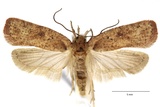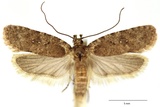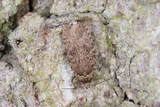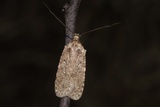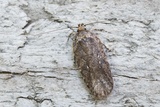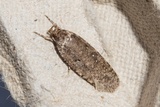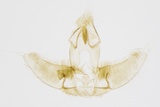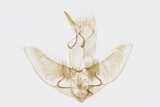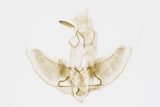Agonopterix heracliana (Linnaeus, 1758) Species
Last modified: Dec. 5, 2025, 8:07 p.m.
A common species throughout Belgium, recorded from all provinces.
Details
- Classification
- Family: Depressariidae > Subfamily: Depressariinae > Genus: Agonopterix > Species: Agonopterix heracliana
- Vernacular names
- Gewone kaartmot (NL)
- Synonyms
- Agonopterix applana (Fabricius, 1777) and Agonopterix cicutella (Hübner, 1796)
- First mention in Belgium
- De Sélys-Longchamps E. 1844. Énumération des insectes Lépidoptères de la Belgique. — Mémoires de la Société royale des Sciences de Liége 2: 1–35. On page 24 (as Haemilis heracliella L.). view page
- Status
-
Native
Distribution
Imago
Can be separated from Agonopteryx ciliella by its smaller size and the presence of only 1 faint grey line in the hindwing cilia.
Caterpillar
Yellowish or greenish with darker green dorsal and dorsolateral lines; head capsule green with a black spot on each side laterally; prothoracic plate greenish with some black dots; last abdominal segment yellowish green with some black dots; pinacula black.
Bionomics
The caterpillar spins some leaves of the foodplant together or constructs a tube by rolling a leaflet downwards. It constructs several such tubes during its development. Sometimes the caterpillar also feeds on the flowers; May-early August.
Pupation in the soil or amongst leaf litter; June–September.
The species hibernate in the adult stage. The adults hide during the daytime, they become active at night and come to light and especially to sugar.
Flight periods
One long generation a year from July onwards and after hibernation till May.
Observed on
- Host plant (species):
- Heracleum sphondylium, Angelica sylvestris and Anthriscus sylvestris
- Host plant (genera):
- Conium, Oenanthe, Silaum, Chaerophyllum and Conopodium
The larva lives on a great variety of Apiaceae, especially on Anthriscus sylvestris, Chaerophyllum temulum and Heracleum sphondylium, but it has also been recorded from Aegododium podagraria, Angelica sylvestris, Conopodium majus, Daucus sylvestris, Meum athamanticum, Myrrhis odorata, Oenanthe sp., Pastinaca sativa, Silaum silaus, Sison amomum, Smyrnium alusatrum, Torilis, Ligusticum scoticum, etc.
